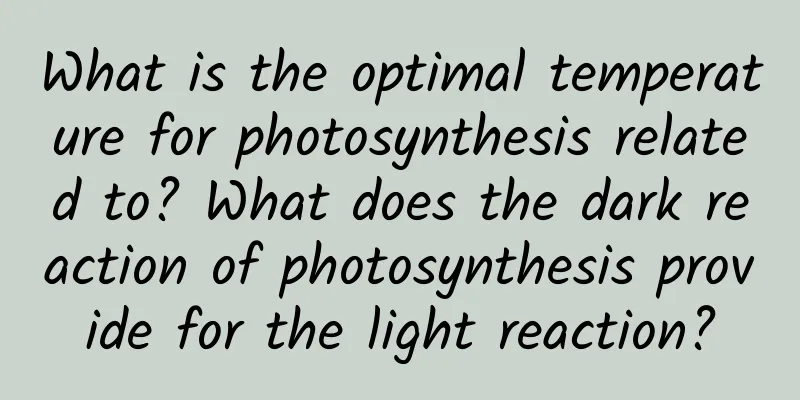What is the optimal temperature for photosynthesis related to? What does the dark reaction of photosynthesis provide for the light reaction?

|
Photosynthesis, or the synthesis of light energy, is a biochemical process in which plants, algae, and some bacteria, under the irradiation of visible light, use photosynthetic pigments to convert carbon dioxide and water into organic matter and release oxygen through light and dark reactions. The following article shares with you what the optimum temperature of photosynthesis is related to and what the dark reaction of photosynthesis provides for the light reaction. Let's learn more about it slowly. Contents of this article 1. What is the optimum temperature for photosynthesis related to? 2. What does the dark reaction of photosynthesis provide for the light reaction? 3. The main product of photosynthesis is 4. The oxygen produced by photosynthesis comes from 5. Where does the oxygen produced by photosynthesis come from? 1What is the optimum temperature for photosynthesis?Too high or too low temperature will affect the activity of enzymes involved in photosynthesis in plants, thereby affecting the intensity of photosynthesis. Different plants have different suitable temperatures. To promote growth, you can increase the concentration of carbon dioxide, raise it to a suitable temperature, increase fertilizer, and increase the oxygen that the roots can absorb. Photosynthesis, or light energy synthesis, is a biochemical process in which plants, algae, and certain bacteria, under the irradiation of visible light, use photosynthetic pigments to convert carbon dioxide and water into organic matter and release oxygen through light and dark reactions. 2What does the dark reaction of photosynthesis provide for the light reaction?The dark phase of photosynthesis is the chemical reaction in the second phase of photosynthesis. 1. Location: chloroplast matrix. 2. CO2 C5 generates two C3 (fixation of carbon dioxide). 3. C3 energy (ATP) is reduced by [H] to generate carbohydrates (which are stored) and form C5. 4. The part of photosynthesis that produces organic matter is also the part that consumes CO2. 5. The dark reaction actually provides Pi and ADP for the light reaction. 3The main product of photosynthesis isThe first sugar synthesized by most plants through photosynthesis is glucose, but glucose quickly turns into starch and is temporarily stored in chloroplasts before being transported to various parts of the plant body. Plants can also synthesize organic substances such as proteins and lipids through photosynthesis. Under sunlight, green plants absorb carbon dioxide and water from the outside world and use light energy to synthesize organic matter in chloroplasts, releasing oxygen. At the same time, light energy is converted into chemical energy and stored in the organic matter produced. This process is called photosynthesis. 4Oxygen produced by photosynthesis comes fromAll the oxygen produced by photosynthesis comes from water. Because photosynthesis is a light reaction that occurs on the chloroplast thylakoid membrane, water is photolyzed, oxygen is released, and reduced hydrogen is produced. Therefore, all the oxygen comes from water. Photosynthesis usually refers to the process in which green plants, including algae, absorb light energy, synthesize carbon dioxide and water into energy-rich organic matter, and release oxygen at the same time. 5Where does the oxygen produced by photosynthesis come from?From water, the light reaction in photosynthesis breaks water down to produce oxygen and hydrogen. Photosynthesis usually refers to the process by which green plants absorb light energy, convert carbon dioxide and water into energy-rich organic matter, and release oxygen at the same time. While assimilating inorganic carbon compounds, plants convert solar energy into chemical energy and store it in the organic compounds formed. The amount of solar energy assimilated by photosynthesis each year is about 10 times the energy required by humans. In addition to being used by the plants themselves and all heterotrophic organisms, the chemical energy stored in organic matter is more importantly a source of energy for human nutrition and activities. |
<<: What is photosynthesis and what is its principle? What is electron transfer in photosynthesis?
>>: Will all orthodontic patients develop braces-like faces? Is there a way to prevent it?
Recommend
Causes of breast hyperplasia cysts
In fact, many young people nowadays do not know h...
Pregnant belly swelling
It is a normal physiological phenomenon for the l...
What does low-grade cin lesions mean?
I believe that everyone is familiar with cervical...
Do I need to fast for medical abortion?
Many women generally choose medical abortion when...
Where are the female fallopian tubes located?
The most important organs for female reproduction...
What skin care products do middle-aged women use?
Skin care products are a necessary weapon for eve...
Symptoms of blocked milk ducts
The healthy development of breasts has an extreme...
Oral ulcers, joint pain...may be a problem with the autoimmune system
"The weather has changed a lot recently, and...
Why do humans get cancer? Is cancer a legacy of evolution?
Why do people get cancer? We can explain it from ...
What to do about gigantic breast disease
Women are born to love beauty, and breasts are ve...
How to cure a woman's dark complexion quickly
For women, there are many reasons that cause thei...
What should I do if I have a cyst in my uterus?
The uterus is an important organ of women. Uterin...
Will eating oranges during pregnancy cause jaundice in the fetus?
Now is the season for oranges. Pregnant women who...
Can I have blood drawn for testing during my period? Why do I have to draw blood from my ring finger?
Some tests require blood tests. So for girls, can...
What happens if there are small lumps in the breast?
Women's breasts are very sensitive and very i...









